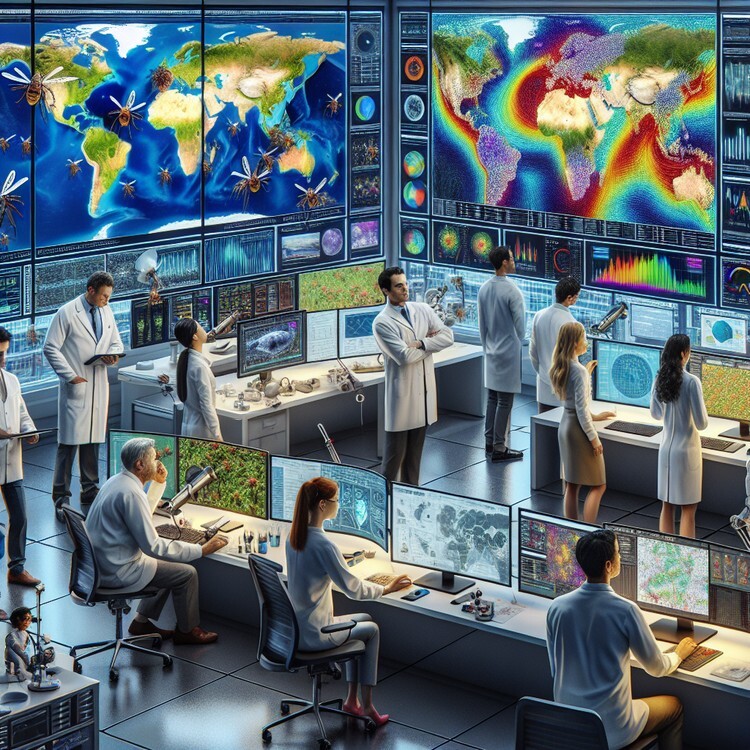Scientists are actively working to combat the spread of climate-fueled diseases, such as dengue, by studying disease-carrying insects like mosquitoes. These insects are adapting to new climates and environments, thriving in warmer and wetter conditions caused by global warming. As leaders gather for COP28, the latest round of climate talks, experts emphasize the profound effect of global warming on global health. In response, scientists are combining insect surveillance with climate forecasts to develop prediction tools for disease outbreaks. By analyzing weather patterns, breeding sites, and other conditions, early warning systems can be implemented to help communities prepare and take preventative measures.
One project funded by the Wellcome Trust is already using satellite images, drone data, and weather sensors to predict disease outbreaks in 12 countries. This information, combined with field research on mosquito populations, provides a better understanding of how climate change impacts insect-borne diseases. The goal is to save lives by identifying high-risk areas and implementing public health campaigns to protect individuals from disease-carrying mosquitoes.
Mosquitoes are highly adaptable insects, capable of surviving in various climates and changing their behavior accordingly. If greenhouse gas emissions continue to rise, our climate will become even more conducive to supporting these mosquitoes, leading to an increase in disease transmission. The number of dengue cases reported to the World Health Organization has already dramatically increased in the last two decades, and countries like Bangladesh have experienced severe outbreaks linked to hotter and wetter conditions.
To address this issue, scientists are developing early warning systems, such as the E-Dengue system, which aims to predict outbreaks two months in advance. By mobilizing communities to take preventative measures, these systems can help alleviate the burden on healthcare systems and save lives. Disease forecasting relies on data from weather stations, drones, and local communities, which is then analyzed by powerful supercomputers to build predictive models. The Harmonize project is currently testing this approach in several countries, with the goal of adapting and implementing it worldwide.
While preventative measures are being taken, experts emphasize the need to curb emissions as the most effective way to address climate change and its impact on human health. Health must be at the center of climate change negotiations, and climate action should prioritize both health and justice. As the problem of climate-fueled diseases continues to worsen, more attention, funding, and focus on these issues are necessary.
Original news source: How scientists are fighting climate-fuelled disease (BBC)
Listen:
Slow
Normal
Fast
Vocabulary:
| 1 | surveillance | The act of closely observing someone or something |
| 2 | profound | Very deep or intense |
| 3 | prediction | The act of foretelling or estimating something in advance |
| 4 | outbreaks | Sudden increase or occurrence of something, especially a disease |
| 5 | understanding | Knowledge or comprehension of a subject or situation |
| 6 | campaigns | Organized efforts to achieve a particular goal |
| 7 | transmission | The act or process of passing something from one person or place to another |
| 8 | dramatic | Sudden and strikingly great in effect or intensity |
| 9 | burden | A heavy load or responsibility |
| 10 | forecasting | The act of predicting or estimating future events or conditions |
| 11 | supercomputers | Powerful computers that can perform complex calculations and process large amounts of data |
| 12 | approach | A method or way of doing something |
| 13 | curb | To control or limit something, especially something negative |
| 14 | prioritize | To give greater importance or precedence to something |
| 15 | funding | Money or financial support provided for a particular purpose |
Group or Classroom Activities
Warm-up Activities:
– News Summary
Instructions: Divide the class into small groups. Assign each group a specific aspect of the article to focus on (e.g., disease-carrying insects, early warning systems, impact on human health, etc.). Each group must then summarize their assigned aspect of the article in a news-style summary, highlighting the key points and using their own words. After a set amount of time, have each group share their summary with the class.
– Opinion Poll
Instructions: Have the class form pairs or small groups. Ask each group to discuss and come up with their opinions on the following questions:
1. Do you think climate change has a significant impact on the spread of diseases?
2. Should more funding be allocated to research and prevention of climate-fueled diseases?
3. What role should individual communities and governments play in combating these diseases?
After a set amount of time, have each group share their opinions with the class, facilitating a discussion on the various perspectives.
– Pros and Cons
Instructions: Divide the class into two groups. Assign one group to brainstorm the pros of implementing early warning systems for disease outbreaks, based on the article. Assign the other group to brainstorm the cons. After a set amount of time, have each group share their lists with the class, discussing the potential benefits and drawbacks of these systems.
– Vocabulary Pictionary
Instructions: Provide the students with a list of key vocabulary words from the article (e.g., climate change, disease outbreaks, early warning systems, etc.). Divide the class into small groups. Each group must select a word from the list and create a visual representation of it through a drawing or sketch. The other groups must then guess the word based on the drawing. This activity can help reinforce the understanding and retention of new vocabulary.
– Future Predictions
Instructions: Divide the class into pairs or small groups. Ask each group to discuss and make predictions about the future impact of climate change on disease transmission. They should consider factors such as rising global temperatures, changing climates, and the ability of disease-carrying insects to adapt. After a set amount of time, have each group share their predictions with the class, encouraging them to support their ideas with evidence from the article and their own reasoning.
Comprehension Questions:
1. What are scientists studying to combat the spread of climate-fueled diseases?
2. How are disease-carrying insects adapting to new climates and environments?
3. What tools are scientists using to develop prediction tools for disease outbreaks?
4. How is the Wellcome Trust-funded project predicting disease outbreaks?
5. Why are mosquitoes capable of surviving in various climates?
6. How has the number of dengue cases changed in the last two decades?
7. What is the goal of the E-Dengue system?
8. What is the Harmonize project testing and what is its goal?
Go to answers ⇩
Listen and Fill in the Gaps:
Scientists are actively working to combat the spread of climate-fueled (1)______, such as dengue, by studying disease-carrying insects like mosquitoes. These insects are adapting to new climates and environments, thriving in warmer and wetter conditions caused by global warming. As leaders gather for (2)______, the latest (3)______ of climate talks, experts emphasize the profound effect of global warming on global health. In response, (4)______ are combining insect surveillance with climate forecasts to develop prediction tools for disease outbreaks. By analyzing weather patterns, breeding sites, and other conditions, early warning systems can be implemented to help communities prepare and take preventative measures.
One project funded by the Wellcome Trust is already using satellite images, (5)______ data, and weather sensors to predict disease outbreaks in 12 countries. This information, combined with field research on (6)______ populations, provides a better (7)______ of how climate change impacts insect-borne diseases. The goal is to save lives by identifying high-risk areas and implementing public health campaigns to protect individuals from disease-carrying mosquitoes.
Mosquitoes are highly adaptable (8)______, capable of surviving in various climates and changing their behavior accordingly. If greenhouse gas emissions continue to rise, our climate will become even more conducive to (9)______ these mosquitoes, leading to an increase in disease transmission. The number of dengue cases reported to the (10)______ Health Organization has already dramatically (11)______ in the last two decades, and countries like Bangladesh have experienced severe outbreaks linked to hotter and wetter conditions.
To address this issue, scientists are developing early warning (12)______, such as the E-Dengue system, which aims to predict outbreaks two months in advance. By mobilizing communities to take preventative measures, these systems can help alleviate the burden on healthcare systems and save lives. Disease forecasting relies on data from weather stations, drones, and (13)______ communities, which is then analyzed by powerful supercomputers to build (14)______ models. The Harmonize project is currently testing this approach in (15)______ countries, with the goal of adapting and implementing it worldwide.
While preventative measures are being taken, experts emphasize the need to curb emissions as the most effective way to address climate change and its impact on human health. Health must be at the center of climate change negotiations, and climate action should prioritize both health and justice. As the problem of climate-fueled diseases continues to worsen, more (16)______, funding, and focus on these issues are necessary.
Go to answers ⇩
Discussion Questions:
Students can ask a partner these questions, or discuss them as a group.
1. What is a climate-fueled disease? How are these diseases spreading?
2. How would you feel if you lived in an area with a high risk of disease outbreaks caused by climate change?
3. Do you think it is important for scientists to study disease-carrying insects like mosquitoes? Why or why not?
4. What are some ways that scientists can use technology to predict disease outbreaks?
5. How do you think early warning systems can help communities prepare for disease outbreaks?
6. Do you think it is possible to completely eliminate disease-carrying mosquitoes? Why or why not?
7. How do you think climate change is impacting the spread of diseases like dengue?
8. What measures do you think should be taken to address the issue of climate-fueled diseases?
9. How do you think early warning systems can alleviate the burden on healthcare systems?
10. Do you think it is the responsibility of individuals to take preventative measures against climate-fueled diseases? Why or why not?
11. How would you feel if your country experienced a severe outbreak of a climate-fueled disease?
12. Do you think the focus on climate change negotiations should prioritize health and justice? Why or why not?
13. How do you think climate change is affecting the most vulnerable populations in terms of disease outbreaks?
14. What do you think would happen if greenhouse gas emissions continue to rise unchecked?
15. How do you think increased attention, funding, and focus on climate-fueled diseases could make a difference?
Individual Activities
Vocabulary Meanings:
Match each word to its meaning.
Words:
1. surveillance
2. profound
3. prediction
4. outbreaks
5. understanding
6. campaigns
7. transmission
8. dramatic
9. burden
10. forecasting
11. supercomputers
12. approach
13. curb
14. prioritize
15. funding
Meanings:
(A) Powerful computers that can perform complex calculations and process large amounts of data
(B) Money or financial support provided for a particular purpose
(C) To control or limit something, especially something negative
(D) Sudden increase or occurrence of something, especially a disease
(E) The act of foretelling or estimating something in advance
(F) A heavy load or responsibility
(G) A method or way of doing something
(H) The act or process of passing something from one person or place to another
(I) Organized efforts to achieve a particular goal
(J) The act of predicting or estimating future events or conditions
(K) Knowledge or comprehension of a subject or situation
(L) Very deep or intense
(M) The act of closely observing someone or something
(N) Sudden and strikingly great in effect or intensity
(O) To give greater importance or precedence to something
Go to answers ⇩
Multiple Choice Questions:
1. What are scientists studying to combat the spread of climate-fueled diseases?
(a) Weather patterns
(b) Disease-carrying insects like mosquitoes
(c) Greenhouse gas emissions
(d) Climate forecasts
2. How are scientists combining insect surveillance with climate forecasts?
(a) By developing prediction tools for disease outbreaks
(b) By analyzing weather stations
(c) By implementing early warning systems
(d) By mobilizing communities
3. What is the goal of the project funded by the Wellcome Trust?
(a) To save lives by identifying high-risk areas
(b) To study mosquito populations
(c) To predict disease outbreaks in 12 countries
(d) To analyze satellite images
4. How are mosquitoes adapting to new climates and environments?
(a) By decreasing in population
(b) By becoming less adaptable
(c) By changing their behavior accordingly
(d) By migrating to colder regions
5. What has happened to the number of dengue cases reported to the World Health Organization in the last two decades?
(a) It has remained the same
(b) It has decreased significantly
(c) It has fluctuated unpredictably
(d) It has dramatically increased
6. What is the goal of the E-Dengue system?
(a) To mobilize communities to take preventative measures
(b) To analyze data from weather stations
(c) To build predictive models
(d) To predict outbreaks two months in advance
7. What is the Harmonize project currently testing?
(a) The use of drones in disease forecasting
(b) The impact of climate change on human health
(c) The effectiveness of early warning systems
(d) The implementation of predictive models worldwide
8. What is the most effective way to address climate change and its impact on human health?
(a) Implementing early warning systems
(b) Curbing emissions
(c) Analyzing weather patterns
(d) Mobilizing communities
Go to answers ⇩
True or False Questions:
1. One project funded by the Wellcome Trust is not using satellite images, drone data, and weather sensors to predict disease outbreaks in 12 countries.
2. Mosquitoes are adapting to new climates and environments caused by global warming.
3. Scientists are combining insect surveillance with climate forecasts to develop prediction tools for disease outbreaks.
4. Scientists are not developing early warning systems, such as the E-Dengue system, to predict outbreaks and mobilize communities to take preventative measures.
5. Climate change has a profound effect on global health, as discussed at COP28.
6. Mosquitoes are not highly adaptable insects that can survive in various climates and change their behavior accordingly.
7. Scientists are not studying disease-carrying insects like mosquitoes to combat the spread of climate-fueled diseases.
8. The number of dengue cases reported to the World Health Organization has increased in the last two decades.
Go to answers ⇩
Write a Summary:
Write a summary of this news article in two sentences.
Check your writing now with the best free AI for English writing!
Writing Questions:
Answer the following questions. Write as much as you can for each answer.
Check your answers with our free English writing assistant!
1. How are scientists using insect surveillance and climate forecasts to combat the spread of climate-fueled diseases?
2. What tools are being used to predict disease outbreaks in 12 countries?
3. How are mosquitoes adapting to climate change and what impact does this have on disease transmission?
4. What is the goal of early warning systems like the E-Dengue system?
5. What is the role of curbing emissions in addressing climate change and its impact on human health?
Answers
Comprehension Question Answers:
1. Scientists are studying disease-carrying insects like mosquitoes.
2. Disease-carrying insects are adapting to new climates and environments by thriving in warmer and wetter conditions caused by global warming.
3. Scientists are using satellite images, drone data, and weather sensors to develop prediction tools for disease outbreaks.
4. The Wellcome Trust-funded project is predicting disease outbreaks by combining satellite images, drone data, weather sensors, and field research on mosquito populations.
5. Mosquitoes are capable of surviving in various climates because they are highly adaptable insects and can change their behavior accordingly.
6. The number of dengue cases reported to the World Health Organization has dramatically increased in the last two decades.
7. The goal of the E-Dengue system is to predict disease outbreaks two months in advance and mobilize communities to take preventative measures.
8. The Harmonize project is testing the use of data from weather stations, drones, and local communities to build predictive models for disease outbreaks. Its goal is to adapt and implement this approach worldwide.
Go back to questions ⇧
Listen and Fill in the Gaps Answers:
(1) diseases
(2) COP28
(3) round
(4) scientists
(5) drone
(6) mosquito
(7) understanding
(8) insects
(9) supporting
(10) World
(11) increased
(12) systems
(13) local
(14) predictive
(15) several
(16) attention
Go back to questions ⇧
Vocabulary Meanings Answers:
1. surveillance
Answer: (M) The act of closely observing someone or something
2. profound
Answer: (L) Very deep or intense
3. prediction
Answer: (E) The act of foretelling or estimating something in advance
4. outbreaks
Answer: (D) Sudden increase or occurrence of something, especially a disease
5. understanding
Answer: (K) Knowledge or comprehension of a subject or situation
6. campaigns
Answer: (I) Organized efforts to achieve a particular goal
7. transmission
Answer: (H) The act or process of passing something from one person or place to another
8. dramatic
Answer: (N) Sudden and strikingly great in effect or intensity
9. burden
Answer: (F) A heavy load or responsibility
10. forecasting
Answer: (J) The act of predicting or estimating future events or conditions
11. supercomputers
Answer: (A) Powerful computers that can perform complex calculations and process large amounts of data
12. approach
Answer: (G) A method or way of doing something
13. curb
Answer: (C) To control or limit something, especially something negative
14. prioritize
Answer: (O) To give greater importance or precedence to something
15. funding
Answer: (B) Money or financial support provided for a particular purpose
Go back to questions ⇧
Multiple Choice Answers:
1. What are scientists studying to combat the spread of climate-fueled diseases?
Answer: (b) Disease-carrying insects like mosquitoes
2. How are scientists combining insect surveillance with climate forecasts?
Answer: (a) By developing prediction tools for disease outbreaks
3. What is the goal of the project funded by the Wellcome Trust?
Answer: (c) To predict disease outbreaks in 12 countries
4. How are mosquitoes adapting to new climates and environments?
Answer: (c) By changing their behavior accordingly
5. What has happened to the number of dengue cases reported to the World Health Organization in the last two decades?
Answer: (d) It has dramatically increased
6. What is the goal of the E-Dengue system?
Answer: (d) To predict outbreaks two months in advance
7. What is the Harmonize project currently testing?
Answer: (a) The use of drones in disease forecasting
8. What is the most effective way to address climate change and its impact on human health?
Answer: (b) Curbing emissions
Go back to questions ⇧
True or False Answers:
1. One project funded by the Wellcome Trust is not using satellite images, drone data, and weather sensors to predict disease outbreaks in 12 countries. (Answer: False)
2. Mosquitoes are adapting to new climates and environments caused by global warming. (Answer: True)
3. Scientists are combining insect surveillance with climate forecasts to develop prediction tools for disease outbreaks. (Answer: True)
4. Scientists are not developing early warning systems, such as the E-Dengue system, to predict outbreaks and mobilize communities to take preventative measures. (Answer: False)
5. Climate change has a profound effect on global health, as discussed at COP28. (Answer: True)
6. Mosquitoes are not highly adaptable insects that can survive in various climates and change their behavior accordingly. (Answer: False)
7. Scientists are not studying disease-carrying insects like mosquitoes to combat the spread of climate-fueled diseases. (Answer: False)
8. The number of dengue cases reported to the World Health Organization has increased in the last two decades. (Answer: True)
Go back to questions ⇧













